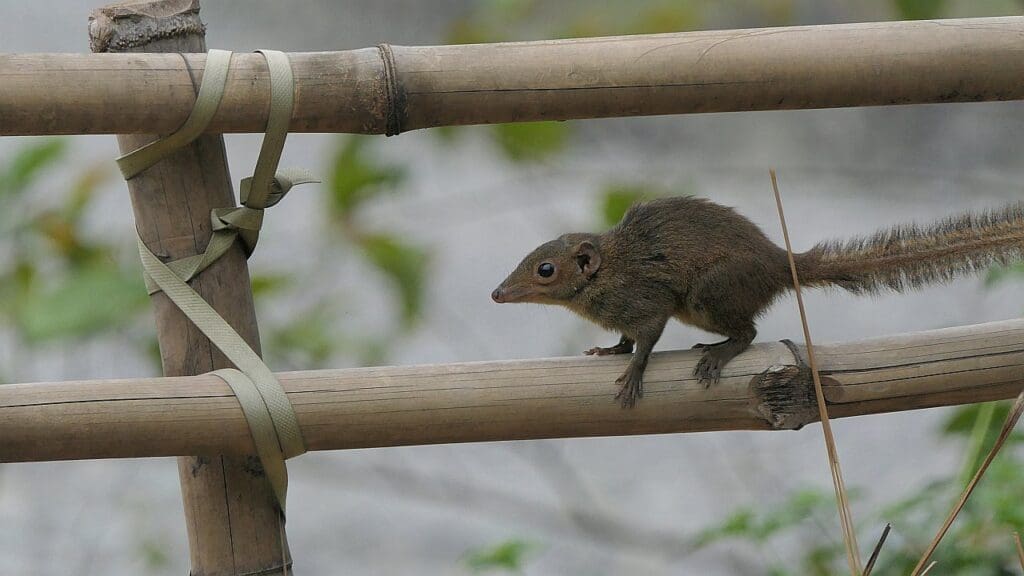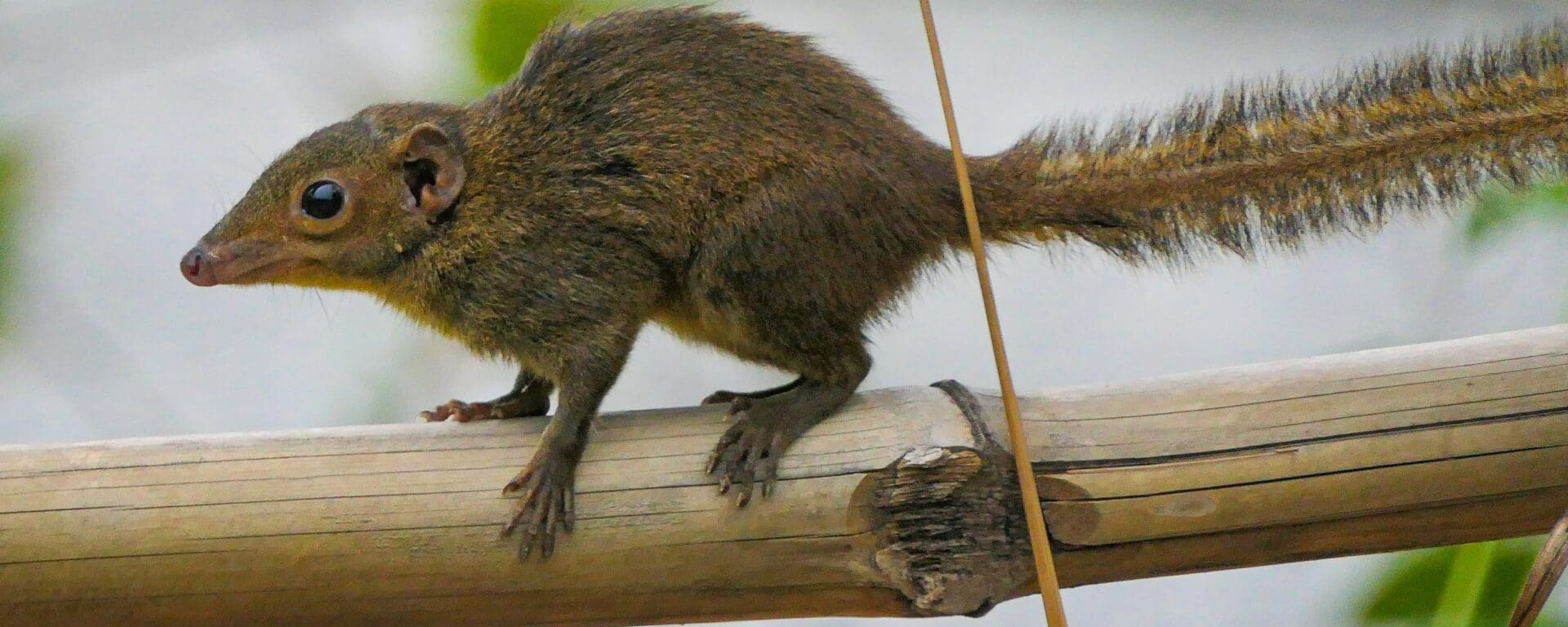Running into the Northern Treeshrew in Arunachal Pradesh made me realise how far away I was from the mainland that my ignorance acknowledged as India. Here, in this exhilarating biogeographical region where the Palearctic and Indomalayan zones collided, the biodiversity was unexpected and surprising. More fascinating was the epiphany that this tiny creature resembling a squirrel with a pointy snout was actually more closely related to primates (like us!). That means it had more in common with me than with a sewer rat. Wow!
Here’s the story…
In April 2021, just a few weeks before the second wave of the COVID-19 pandemic swept into killer mode, I found myself sheltering from the rain in a tent pitched on the bank of the Dibang River, which roared into Arunachal Pradesh’s Lower Dibang Valley from its mountainous sources in China. I was volunteering with a Wildlife Trust Of India expedition to explore and document habitats for the White-winged Wood Duck in Arunachal Pradesh. Although we never saw the bird during my 15-day stint, I was afforded a unique opportunity to explore wild habitats in Mishmi Hills and other nooks of the Lower Dibang and Lohit valleys. I joined the search team, which comprised wildlife biologist Aftab Ahmed (who doubled as expedition lead and expert driver of a weather-beaten Mahindra Bolero pickup at the fag end of its lifetime) and our scout Chipra, a young man of the Idu Mishmi tribe whose comprehensive portfolio was to cook, heft our luggage, guide, and cut our way out of the mazes we ended up in. On some trips, we had the pleasant company of Chipra’s cousin Koto, a talented photographer, driver, and expert chef. With our base at Roing, at the gateway to Mishmi Hills, we explored a variety of habitats for 13 days in the wet, humid forests, our high point being the ascent to Mehao Lake inside the Mehao Wildlife Sanctuary.
Some time in February 2021, I had chanced upon a social media post by Vivek Menon, founder and executive director of WTI, calling for volunteers for this project. I didn’t think twice before applying, and was instantly accepted. At the moment, I had no idea what I was signing up for. For a city-slicker in his late forties, this didn’t seem like a sane thing to do. But I had so thirsted for the wilderness during the lockdowns that getting out, far and away from the masked mobs of containment-zone suburbia, seemed an ideal escape.
The treks in the steep, densely forested Mishmi Hills were some of the hardest I have ever done, and the wild-camping was exciting. Bruised by falls, drenched by steady rain, stung by nettles, bitten by murderous leeches, and shaken out of my wits by the harsh terrain, but still in thrall of the wildlife and landscapes, I marvelled every day at what I had been fortunate to experience.
The rest days, where we returned to civilisation in Roing for hot baths, decent meals, laundry, charging gadgets, sleeping on actual mattresses, and enjoying the privilege of using a closed-door lavatory, were much coveted. Between chores, I would spend my downtime watching birds in the vast backyard overlooking the gorge where the mighty Dibang river roared over its bellyful of boulders. I grew familiar with the sights and sounds of the regulars — the Eurasian Tree Sparrows that kept up a steady chittering, the love quarrels of the tiny Himalayan Striped Squirrels, and the madhouse wails of the Hoolock Gibbons from the other side of the river. Among the quieter denizens were the butterflies, lizards, an inquisitive Beautiful Sibia, and an overconfident Taiga Flycatcher that lived in the backyard.
One afternoon, drying myself out in a hard-to-get scrap of sunshine, I peered over the bamboo fence separating the cliff where I was standing from the river gushing below. I caught a movement near my feet from the corner of my eye. A shy creature watched me from the shrubbery. Its shape suggested a mammal, probably a mouse or a squirrel. I froze, and waited patiently for it to come into view. A pointy little head, bald and wizened, with large round eyes and enormous ears like a Hobbit’s, poked out of the foliage and quickly shot past me along the fence. For an instant, my eyes registered the animal’s full form as they might an image in the window of a tachistoscope. Feverishly, I shot a burst of pictures. Somewhere in that ephemera, our mammalian eyes met, and the creature vanished into the undergrowth.

Just one clear picture survived that photographic blitz. Looking at it, I knew I had seen something new. A quick exchange of texts with Vivek Menon, who is also the author of the most authoritative field guide to Indian mammals, confirmed my suspicion. In appearance, this little mammal resembled a squirrel, with a bushy bottle-brush of a tail. But that long snout, very unlike a squirrel’s, established it as a treeshrew, specifically a Northern Treeshrew (Tupaia belangeri).
Treeshrews are evolutionary puzzles. While they resemble squirrels, they are in fact more closely related to primates. Classified under the order Scandentia, they are diurnal mammals that eat insects and fruit. When newly discovered, treeshrews were thought to be insectivores (hence, shrew) but were later classified as primates but were again split and moved into a new clade of their own. Taxonomists are still not on the same page on this: some have proposed that they be classified along with primates and colugos in a separate grandorder called Euarchonta. Currently, four orders are recognised with 23 species. Of these, three are known to occur within the boundaries of India, one of which is the endangered Nicobar Treeshrew. In peninsular India, we get the Madras Treeshrew.
As always with me, it is discovering smaller mammals that excites me the most. Which is not to say that I don’t enjoy spotting tigers or elephants, but one doesn’t always get to spot a Treeshrew on a tiger safari.
Wait, scratch that. Didn’t Andy spot his Madras Treeshrew while watching tigers in Tadoba?
Post-script:
My review of the latest edition of Indian Mammals – A Field Guide by Vivek Menon; Hachette India was published in India Today. Read it here
- Dimorphic Egret – Meet this East African mystery bird - June 8, 2024
- Encounter: Northern Treeshrew in Arunachal Pradesh - May 19, 2024
- Indian Nightjar, Sweet Child O’Mine - February 21, 2024


There is no other like Beej. Have always immensely enjoyed reading his posts/blogs. And have always come away enriched. Thank you, Bijoy.
Thank you so much, Jennifer! 🙂